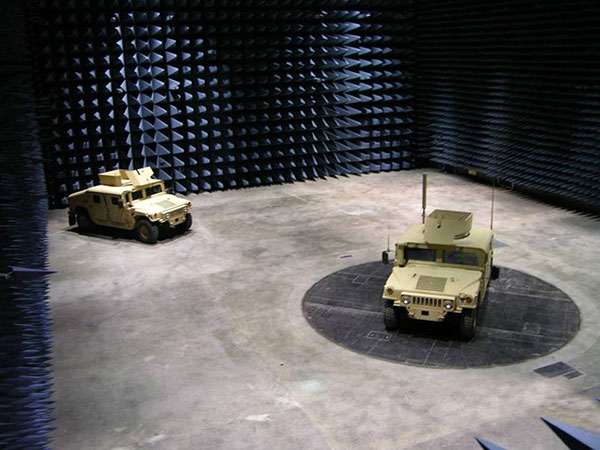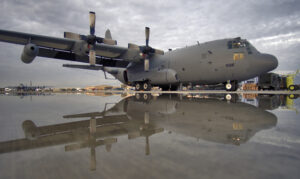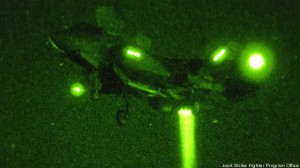
Inside an Army electronic warfare testing facility at White Sands.
WASHINGTON: If you know both the enemy and yourself, you will not be defeated in a hundred….ducks?
“We’ve got twenty shotgun shells and a hundred ducks” in the electronic warfare world today, lamented Strategic Command’s Rear Adm. John R. Haley this morning. “There are so many devices out there and so many things being used.”
That proliferation of potential targets has major implications for how the American approach to EW has to change. Once upon a time, the “ducks” we had to keep track of were relatively few and well-defined: Soviet air-defense radars and headquarters radio transmitters, for example. But today there are more cellphone users in Afghanistan than people who know how to read, and some of them are Taliban, using those cheap, low-power, and widely available civilian systems to coordinate military operations. The electromagnetic spectrum — especially in cities — has become a buzzing, blooming confusion of signals emitted by everything from iPhones to advanced anti-aircraft missile batteries.

A Navy electronic warfare technician.
Historically, the military, the media, and Congress have focused on a small number of high-profile systems, Haley’s handful of shotgun shells: The Navy EA-18G Growler and the new Next-Generation Jammer (NGJ) being developed to go on it; the Army’s CREW (Counter Radio Electronic Warfare) jammer to shut down roadside bombs; the Air Force’s EC-130H Compass Call. Those individual pieces of equipment remain important, Haley said, but as the electromagnetic battlefield becomes ever more complicated and confusing, “all these systems have to be enabled by something that wraps [then] up into an electromagnetic battle management system.”
EMBM — to use the truly appalling acronym — was the major focus of today’s panel of military officers at the Association of Old Crows (AOC) electronic warfare conference, where Haley was the senior speaker.
“We like the sexiness of effects, delivery, and battle damage assessment, [but] sometimes we pole vault over planning and management,” said Richard Wittstruck, the Army’s acting deputy program executive officer for Intelligence, Electronic Warfare and Sensors (IEW&S). But if you want to “shoot a hundred ducks with twenty rounds,” he said, continuing Haley’s metaphor, you need some system to identify “which of those hundred ducks are important [in terms of] your military objectives and how do we prioritize them based on the intelligence we’ve received?”
The system “will have to be able to filter out those things that just don’t matter at that time for that particular warfighter,” said Air Force Col. Marcus “Shaka” Boyd of the 608th Air and Space Operations Center. “That’s where — again — battle management… is really going to come into play, to define what those filter algorithms will actually be.”

An Air Force EC-130H Compass Call electronic warfare aircraft in Afghanistan.
With ever more friendly, neutral, and enemy emissions on the battlefield, the optimal employment of our own electronic warfare systems “is going to change from day to day and in some cases from second to second,” Boyd said. (In fact, an article in the October Journal of Electronic Defense suggests only autonomous artificial intelligence can keep up).You may have great individual systems for electronic attack, protection, and support, Boyd said, but if you have inadequate battle management, you’ll get inferior results. In one case in Afghanistan, he recalled, a unit inadvertently jammed the data links being used by special operations. On the other hand, he said, if we get battle management right, it multiplies the effectiveness of all the individual systems.
So who’s getting it right?
The Army rolled out new doctrine for Cyber Electromagnetic Activities in February and will unveil a new “electronic warfare planning & management tool” (EWPMT) at next week’s Association of the US Army conference. “The Army is back in the EW business,” Wittstruck said.
Haley, however, said that “the Marine Corps is probably furthest down along the road. The Commandant has the Marine Corps working electromagnetic spectrum battle management in a system that is real today — software with computers — and actually working. It’s not operational yet but it’s a lot closer than what everybody else has.”
“We tend to look at this problem as overwhelming and I think it’s actually pretty manageable,” said Marine Col. Richard “Otter” Bew, the Commandant’s deputy legislative liaison. Yes, there are more and more transmitters — friendly, enemy, and civilian — in any given geographical area, he said. But different users tend to be on different wavelengths (otherwise they’d interfere with each other), and the US military has remarkable capability to sort them out.
That said, the Marine’s new electromagnetic battle management system is not yet a “program of record” officially enshrined in the budget Bew cautioned me and another reporter after the panel.
Nor is Bew sanguine that the Marines’ venerable EA-6B Prowler is going away with no replacement. “How do you maintain a cadre of expertise when there’s no platform?” he asked the other panelists. Unlike the Navy, “the Marine Corps is not going to buy the EA-18G [Growler],” Bew told me and the other journalist.

A Marine F-35B in vertical landing mode.
That doesn’t mean Marine strike fighters become more vulnerable, he said, because the Corps is replacing its old F-18 Hornets with the new F-35B, which has not only stealth but also some electronic warfare capabilities of its own. “If you take four F-18s that the Marine Corps flies supported by a Prowler, and you take four F-35s not supported by a Prowler… which package is more survivable?” he asked. “You would probably conclude that I haven’t given anything up in terms of strike package survivability.”
But the Marines are giving up the Prowler’s ability to provide electronic warfare support to the rest of the force, including ground troops and non-stealthy aircraft. “We still have an EW requirement,” he said. “Addressing that piece is something that the Deputy Commandant for Aviation, the Deputy Commandant for Capabilities Development and Integration, and the Commandant of the Marine Corps have been engaged in.”
Whatever answer they come up with, Bew said, “it’s going to be fundamentally different from how we do EW today.”
In a ‘world first,’ DARPA project demonstrates AI dogfighting in real jet
“The potential for machine learning in aviation, whether military or civil, is enormous,” said Air Force Col. James Valpiani. “And these fundamental questions of how do we do it, how do we do it safely, how do we train them, are the questions that we are trying to get after.”


























